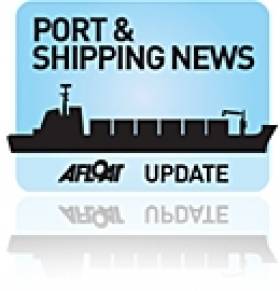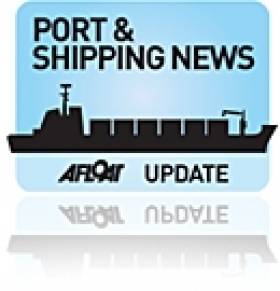Displaying items by tag: Airbus A380 Onboard
Refloated Airbus Wing-Carrier Leaves UK Waters
#AIRBUSship -As previously reported, the Airbus wing-carriership Ciudad de Cadiz (2009 /15,643grt) which was refloated off Mostyn over a week ago, arrived in Falmouth today, writes Jehan Ashmore.
Following the refloating of Ciudad de Cadiz which had arrived to load the wings, she sailed to Holyhead. The vessel had been anchored off the Anglesey port since last Sunday and where divers were to make hull inspections.
It is understood that Ville de Bordeaux was brought in to Mostyn, so to load the Airbus A380 wings constructed at the BAe factory at Broughton.
The Marseille-registered Ciudad de Cadiz, stayed in Falmouth until this evening, where she is heading for Pasajas, near the Spanish-French border.
Both vessels are jointly operated by French owners Louis Dreyfus Armateurs (through its subsidiary FRET SETAM) and Norwegian vehicle-carrier shipping company, Leif Höegh Autoliners.
Ports & Shipping Review: Fenit’s Crane Exports, Cork’s Energy Deal, Belfast’s Tonnage Record, Grounded Airbus Wingship Re-floated plus more…
P&SReview – Over the last fortnight, Jehan Ashmore has reported from the shipping scene, where the Stade, a cargo vessel rode out bad weather before docking at Fenit to load cranes built by Liebherr in Killarney, which as previously reported has received an order from the New Zealand port of Lyttelton.
The Port of Cork Company have signed up with Sustainable Energy Authority of Ireland (SEAI) in targets for improved energy efficiency set for 2020.
Drogheda Port handled over 1m tonnes of cargo, this level in throughput has not been surpassed since 2007. The Co. Louth port is to welcome a flotilla of tallships during the Drogheda Fringe Festival over the May Bank holiday.
For the first time, Paris will host this year's European (Shortsea '13) Conference on 14 March at La Defense. Last year the IMDO hosted the event in Dublin's Mansion House.
Ports across Europe urged governments not to touch the envelope of €31.7billion foreseen for Europe's transport infrastructure investments under the Connecting Europe Facility (CEF).
Belfast Harbour had a record 19.6m tonnes in 2012, up 11% on the previous year. The growth was primarily driven from the bulk and roll-on/roll-off (freight) sectors.
Irish Ferries fast-craft catamaran Jonathan Swift, returned fresh from dry-docking, she operates the Dublin-Holyhead route, where she clocks up an impressive 162,000kms each year.
A grounded ship that carries wings for the Airbus A380, Ciudad de Cadiz (2008/15,643grt) was re-floated yesterday, having broke moorings during a gale in late January off the Welsh port of Mostyn.
Airbus Wing-Carrier Vessel Refloated off Welsh Sandbank
#WINGSHIPRefloated – A ship designed specifically to transport huge Airbus A380 wings, Ciudad de Cadiz (2008/15,643grt) was successfully refloated this morning, following grounding on a north Welsh sandbank off Mostyn, more than a week ago, writes Jehan Ashmore.
The 125m vessel which operates between the port of Mostyn in Flintshire to Nantes, France, grounded on the Salisbury Sandbank on the Dee Estuary during 30 January.
She broke her moorings due to the severe weather conditions that led to the vessel beaching on the sandbank and within 1 nautical mile off the port's pier, to where she is now safely moored alongside.
| ShipSpotting.com |
 |
| © Barry Graham |
Previous attempts to free the vessel which has no cargo on board, failed due to the continued gales and insufficient tidal heights.
The vessel was ballasted down and in an upright and safe position with tugs in attendance while the Maritime Coastguard Agency (MCA) monitored the situaton. There were no reports of damage or pollution and that her 23 crew were reported safe and well remained onboard.
According to BCC North East Wales, the vessel is to head to Holyhead to undergo a full dive survey.
Ciudad de Cadiz, is one of three such specialist vessels that transport the wings manufactured at an Airbus plant at Broughton, from there they are firstly taken by road, then driven onto a custom-built stern-loading barge before finally reaching the port.
The components are then transferred via the pier's ro-ro linkspan and through the ships stern door ramp, and then sailed across the Bay of Biscay to Nantes (Montoir-de-Bretagne). From there the final leg of the journey is by road to the company's assembly factory at Toulouse in south-west France.
One of these ships, Ville de Bordeaux, (2004/21,528grt) had also recently called to Mostyn. The vessel which is jointly operated by two companies, had several years ago called to Rosslare to deliver trade cars, as the French partner's offshoot LD Lines, had run a short lived Rosslare-Le Havre ferry service by the ro-pax Norman Voyager.































































